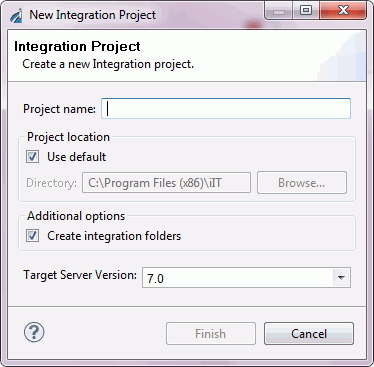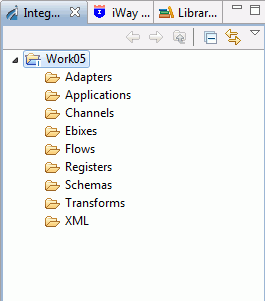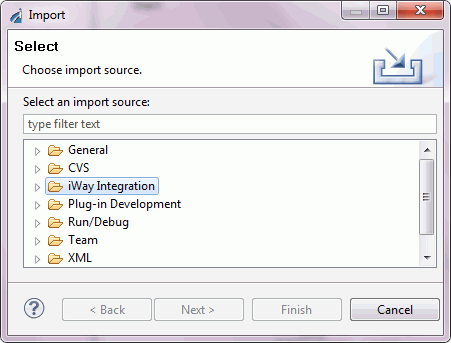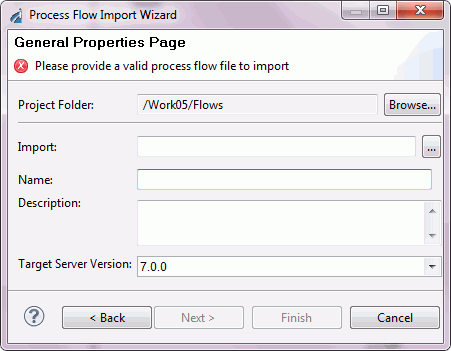Creating a Project
|
Topics: |
|
How to: |
- Adapters
- Applications
- Channels
- Ebixes
- Flows
- Registers
- Schemas
- Transforms
- XML
Procedure: How to Create a Project
To create a project:
- From the
File menu, choose New (or right-click the
repository icon), and click Integration Project.
The New Integration Project dialog box opens, as shown in the following image.

- In the Project name field, type a descriptive name for the project.
- In the Project location field, use the default location, or deselect the Use default box, and browse to the desired location.
- If you do not want to Create integration folders, deselect the corresponding check box in the Additional options section.
- Select the Target Server Version from the drop-down list.
- Click Finish.
The new project, with all the subfolders, appears in the Navigator pane. An example of a new project node, Work05, and its subfolders is shown in the following image.

A newly created project includes the following default elements:
- Adapters. Node contains the adapters available in Service Manager.
- Applications. Node contains the applications available in Service Manager.
- Channels. Node contains the channels available in Service Manager.
- Ebixes. Node contains the ebixes available in Service Manager
- Flows. Node contains the process flows you create for the project.
- Registers. Node contains the registers you create for the project.
- Schemas. Node contains the schema you define, as well as default schemas (PFIVP, PFIVPResponse, and Any).
- Transforms. Node contains the transformation files published on Service Manager.
- XML. Node contains the XML files published on Service Manager.
- To save the project, right-click the project node, and select Save from the drop-down list.
Working with a Project
|
Topics: |
|
How to: |
Once a project exists, you can change its properties and begin to build the project by adding elements, such as process flows, services, adapters, emitters, and schemas. Project elements are either created in iIT or imported to the project. For example, a process flow can be created in iIT Designer or imported from another source, while services, adapters, and emitters are imported from Service Manager.
This section explains how to:
- Open and close a project.
- Refresh a project.
- Import a process flow to a project.
Opening and Closing a Project
To gain access to a project and its components, you must open the project. To open a project, either click the project icon or right-click the project node and select Open Project from the drop-down list. The project node in the Navigator pane expands to display the project components.
To close a project, right-click the project node and select Close Project from the drop-down list. When you close a project, you have the option to save the project. Once a project is closed, it cannot be changed in iIT Designer until it is opened again. Although the resources of a closed project do not appear in the Navigator pane, they still reside on the local file system.
Refreshing a Project
The refresh option reloads a project from the repository and displays the most current version of that project in the Designer window.
To refresh a project, select Refresh from the File menu, or right-click the project and select Refresh from the drop-down list.
Viewing Project Properties
The project properties are the project name, description, where it is stored, and all other information pertaining to that particular project. To view project properties, right‑click the project of interest, and select Properties from the drop‑down list. The properties dialog box opens displaying the following tabs, from which you can obtain project information.
- Resource. Contains the Path, Type, and Location of the project. Also contains the last modified date, Text file encoding options, and New text file line delimiter options.
- Builders. Allows you to configure the builders for the project.
- iWay Integration. Contains the following sections: Application, Customizations, Default iSM Target Versions, Export Folders, IFL Binding Properties, Process Flow and Transformer Encoding.
- Project References. Projects may refer to other projects in the same workspace. Use this page to specify what other projects are referenced by this project.
- Refactoring History. Allows you to view refactorings that affect this project.
- Run/Debug Settings Allows you to manage launch configurations associated with the currently selected resource.
- Task Tags. Allows you to enable project specific task tags.
- Validation. Allows you to select validators for the project.
Importing a Process Flow to a Project
Multiple iIT Designer users can be using a single repository, but only those projects and process flows that you create or import into your project will appear in your instance of iIT Designer. The import feature allows you to bring a process flow used by or created for an outside project, into one or more of your projects.
The following procedure explains how to import a process flow.
Procedure: How to Import a Process Flow
To import a process flow:
- Under the project to which you want to import a process flow, right-click and select Import.
- The Select
dialog box opens, as shown in the following image.

- Expand the iWay
Integration node and select Process Flow,
as shown in the image below

- Click Next.
The General Properties dialog box opens, as shown in the following
image.

The default Flows folder is populated automatically in the Project Folder field. Click Browse to change the location.
To browse to a Process Flow file, click the ellipsis (...) found next to the Import field. Navigate to the file you would like to import. Click Open.
Select the Target Server Version from the drop-down list.
- Click Finish.
The process flow is imported to the selected project and appears in the Navigator pane under the Flows folder.